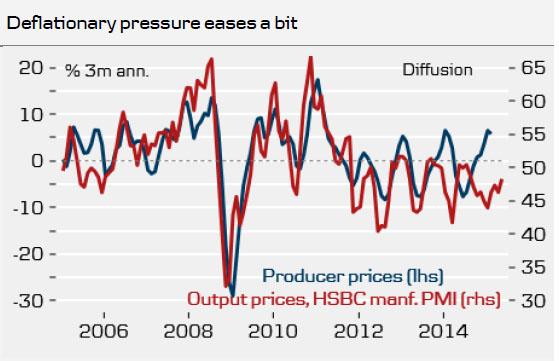In China the flash estimate for HSBC manufacturing PMI in May improved slightly to 49.1 (Consensus: 49.3, DBM: 48.7) from a final reading of 48.9 in April.
The details were relatively strong with new orders improving to 49.3 from 48.9. On a negative note, export orders declined markedly to 46.8 from 50.3 suggesting that the improvement in new orders was driven solely by an improvement in domestic orders. Inventories were cut at a faster pace in May with the finished goods inventory component easing to 49.0 from 49.7 meaning that the new order-inventory balance improved in May. Current output also declined markedly to 48.4 from 50.4 suggesting that new orders are now increasing faster than production.
There were also some signs that the deflationary pressure is easing with the output price component improving to 48.3 from 46.3 (see chart below). For the output price component this is the highest level since August 2014.
The relative strong details in the HSBC manufacturing PMI suggest that the HSBC manufacturing PMI has bottomed out. That said, there is still a considerable gap between the manufacturing PMIs and the hard industrial production data with the hard industrial production data substantially weaker than the manufacturing surveys (see chart below).
Overall today’s HSBC manufacturing PMI supports our view that the Chinese economy will recover moderately in H2 supported by current monetary easing. Hence, the HSBC Markit manufacturing PMI should again improve to above 50 in the coming months. It does not change our view that GDP growth will drop below 7% y/y in Q2 and for that reason we expect to see further monetary easing in the coming months.
In Japan the flash estimate for Markit/JMMA manufacturing PMI in May also improved to 50.9 (consensus: 50.3) from a final reading of 49.9 in April. This is the first improvement since January. The details were also stronger with new orders improving markedly to 51.2 from 48.5. However, also in Japan there was signs of a bit of softness in exports with export orders declining slightly to 50.5 from 51.0 but overall exports are still doing reasonably well. On a positive note, the improvement in new orders appears to be driven mainly by domestic orders. In addition, inventories were cut at a substantially faster pace in May, so the new order-inventory-balance improved markedly in May. So we have a relatively strong signal about further improvement in Japan’s manufacturing PMI in the coming months. With signs that both China's and Japan's manufacturing PMIs are bottoming out, there are tentative signs that the global manufacturing cycle could be stabilising.
This publication has been prepared by Danske Bank for information purposes only. It is not an offer or solicitation of any offer to purchase or sell any financial instrument. Whilst reasonable care has been taken to ensure that its contents are not untrue or misleading, no representation is made as to its accuracy or completeness and no liability is accepted for any loss arising from reliance on it. Danske Bank, its affiliates or staff, may perform services for, solicit business from, hold long or short positions in, or otherwise be interested in the investments (including derivatives), of any issuer mentioned herein. Danske Bank's research analysts are not permitted to invest in securities under coverage in their research sector.
This publication is not intended for private customers in the UK or any person in the US. Danske Bank A/S is regulated by the FSA for the conduct of designated investment business in the UK and is a member of the London Stock Exchange.
Copyright () Danske Bank A/S. All rights reserved. This publication is protected by copyright and may not be reproduced in whole or in part without permission.
Recommended Content
Editors’ Picks
EUR/USD clings to gains above 1.0750 after US data

EUR/USD manages to hold in positive territory above 1.0750 despite retreating from the fresh multi-week high it set above 1.0800 earlier in the day. The US Dollar struggles to find demand following the weaker-than-expected NFP data.
GBP/USD declines below 1.2550 following NFP-inspired upsurge

GBP/USD struggles to preserve its bullish momentum and trades below 1.2550 in the American session. Earlier in the day, the disappointing April jobs report from the US triggered a USD selloff and allowed the pair to reach multi-week highs above 1.2600.
Gold struggles to hold above $2,300 despite falling US yields

Gold stays on the back foot below $2,300 in the American session on Friday. The benchmark 10-year US Treasury bond yield stays in negative territory below 4.6% after weak US data but the improving risk mood doesn't allow XAU/USD to gain traction.
Bitcoin Weekly Forecast: Should you buy BTC here? Premium

Bitcoin (BTC) price shows signs of a potential reversal but lacks confirmation, which has divided the investor community into two – those who are buying the dips and those who are expecting a further correction.
Week ahead – BoE and RBA decisions headline a calm week

Bank of England meets on Thursday, unlikely to signal rate cuts. Reserve Bank of Australia could maintain a higher-for-longer stance. Elsewhere, Bank of Japan releases summary of opinions.

